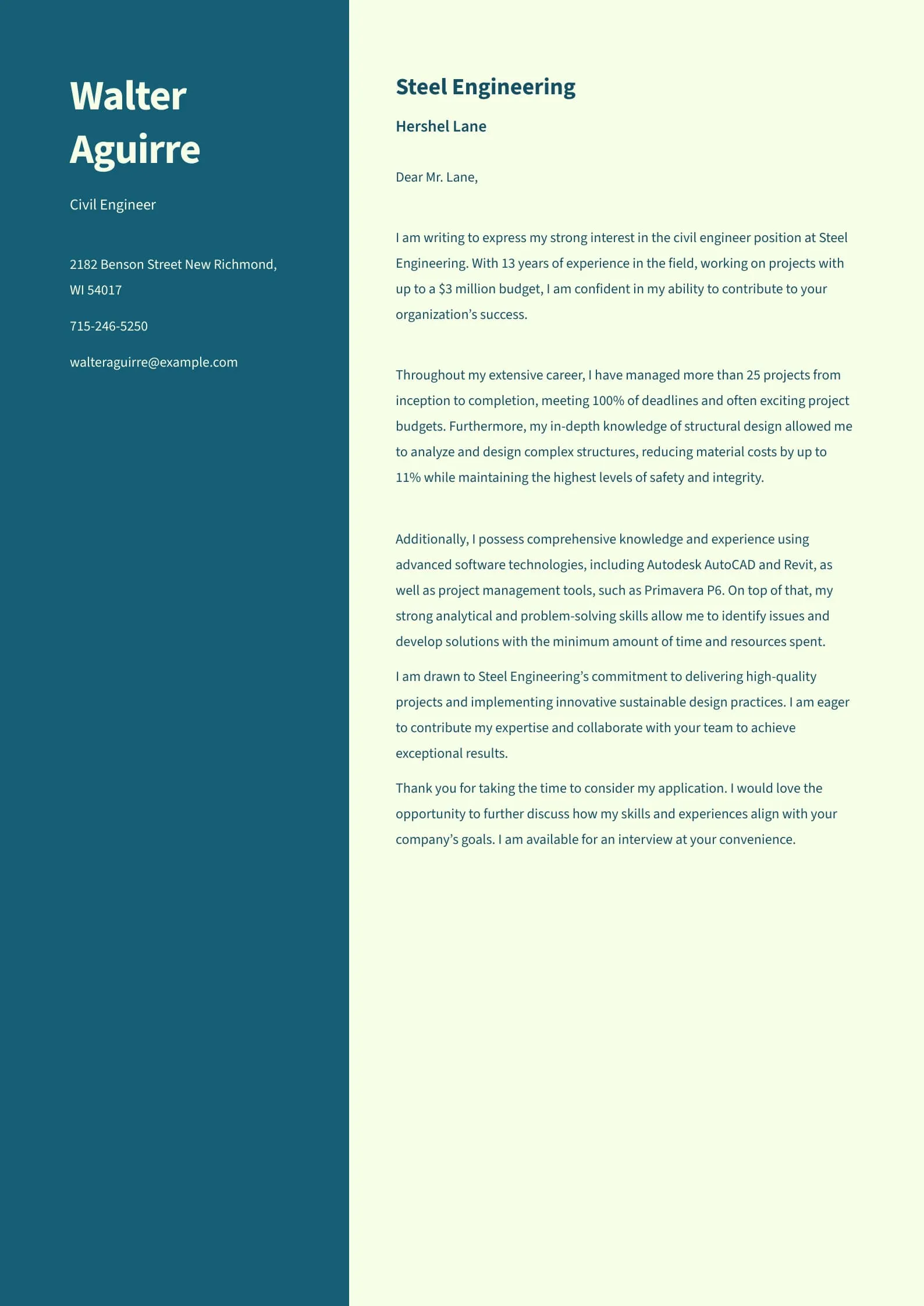What is an Engineer Cover Letter
An engineer cover letter is a crucial document that accompanies your resume when applying for engineering positions. It serves as your first introduction to a potential employer, providing a space for you to highlight your qualifications, skills, and experiences in a way that a resume alone cannot. The cover letter allows you to showcase your personality, express your enthusiasm for the role and the company, and explain why you are the ideal candidate. Essentially, it is your opportunity to make a compelling case for why you should be granted an interview. A well-crafted cover letter significantly increases your chances of getting noticed by recruiters and hiring managers, ultimately leading to an interview and a potential job offer.
Why an Engineer Cover Letter Is Important
The importance of an engineer cover letter cannot be overstated in the competitive job market. It is your chance to personalize your application and go beyond the factual information presented in your resume. By using a cover letter, you can demonstrate your understanding of the specific job requirements and express your genuine interest in the role and the company’s mission. Moreover, a cover letter gives you the space to address any potential gaps in your resume or to explain any career transitions. It allows you to highlight your most relevant skills and experiences, making a strong connection between your qualifications and the needs of the employer. In a nutshell, a well-written cover letter can be the key to unlocking the door to your dream engineering job.
Key Components of a Strong Engineer Cover Letter
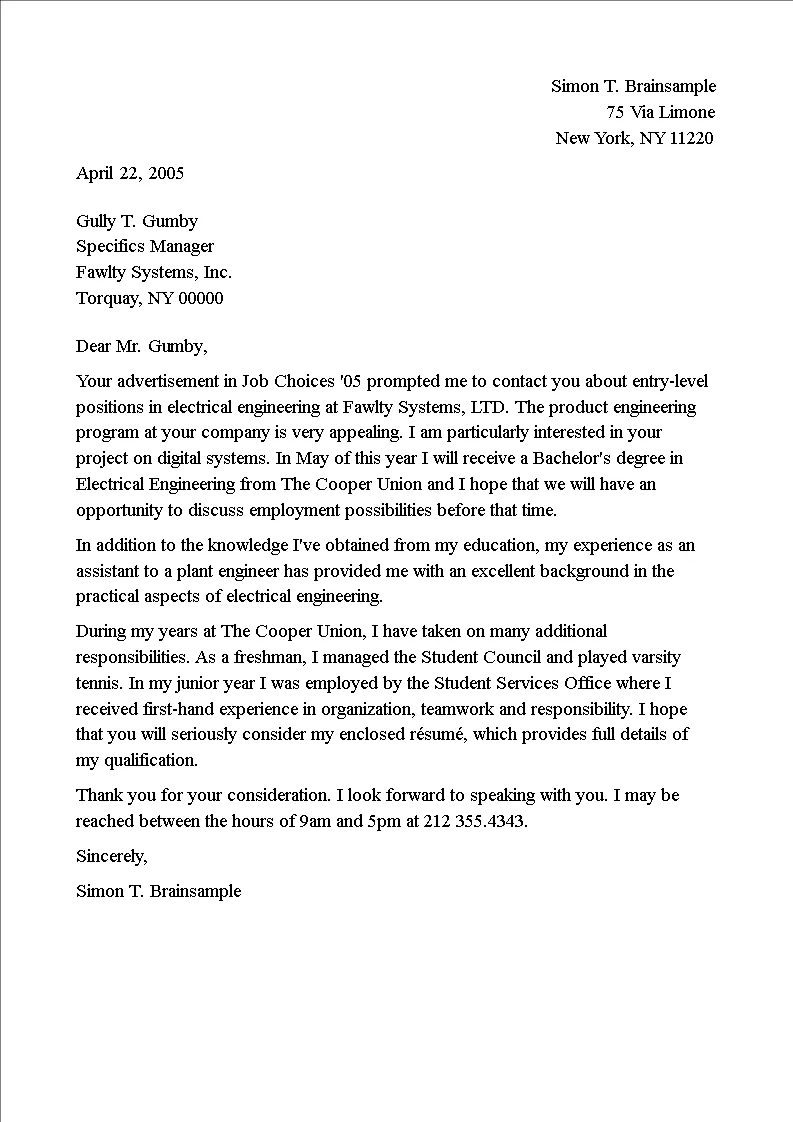
Several key components are essential for creating a strong and effective engineer cover letter. These elements work together to paint a complete picture of your skills, experience, and enthusiasm for the position. They include a professional header, a personalized salutation, a compelling opening paragraph, detailed body paragraphs showcasing relevant skills and accomplishments, and a strong closing paragraph that reiterates your interest and calls for action. It is also critical to tailor your letter to the specific job description and company. By including these key components, you increase the likelihood of making a lasting impression on the hiring manager and securing an interview. Each component must be crafted with precision and clarity to ensure that your cover letter is engaging and effective.
Header of Your Engineer Cover Letter
The header of your engineer cover letter is the first element the hiring manager will see, so it’s essential to create a professional and well-organized header. It should include your full name, address, phone number, and email address. Consider using a clear and legible font. Additionally, the header should be aligned to the left or right of the page. If you know the name of the hiring manager, include the date and their title under the address. This helps to establish a professional tone right from the start, and it also allows for easy contact. Make sure your contact information is current and accurate to avoid any missed opportunities.
How to Address the Hiring Manager
Addressing the hiring manager correctly is essential for creating a positive impression. Whenever possible, use the hiring manager’s name in the salutation. Research the company website or LinkedIn to find the correct name. For example, use ‘Dear Mr. Smith’ or ‘Dear Ms. Jones’. If you are unable to find a specific name, use a general salutation like ‘Dear Hiring Manager’ or ‘Dear [Company Name] Hiring Team’. Avoid generic greetings such as ‘To Whom It May Concern’ as they can make your letter seem impersonal. A personalized salutation shows that you have taken the time to research the company and the position, which demonstrates your interest.
The Opening Paragraph Crafting a Strong First Impression
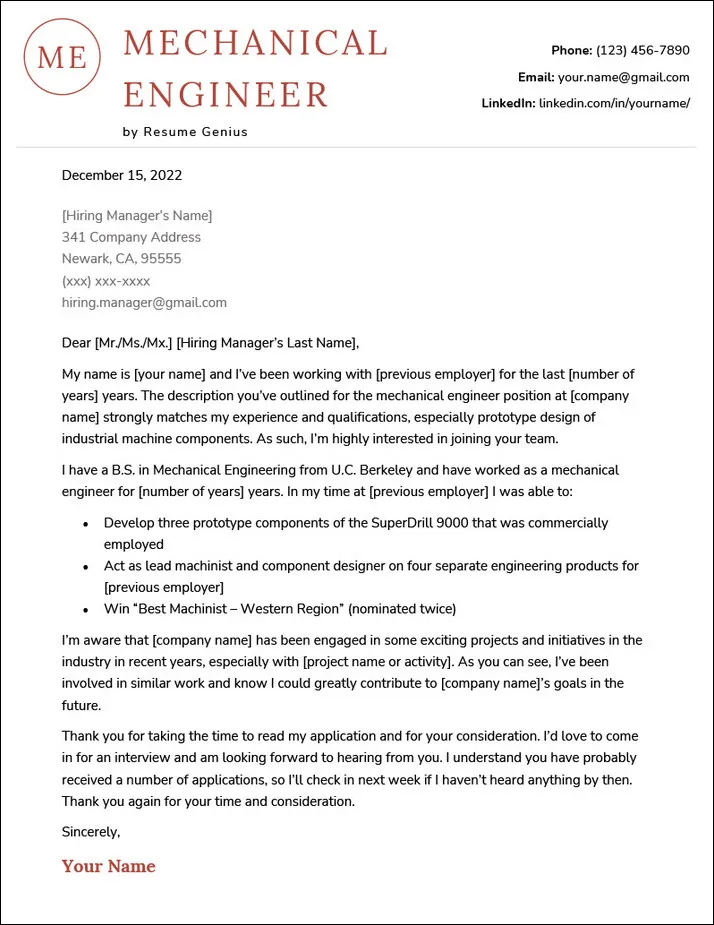
The opening paragraph is your chance to grab the hiring manager’s attention. Start with a strong statement that immediately grabs interest. State the position you are applying for and how you found the job posting. Briefly highlight your most relevant skills or experiences, and express your enthusiasm for the opportunity. Show your understanding of the company’s mission or values to demonstrate your interest in the company. Make sure your opening paragraph is concise, engaging, and tailored to the specific job. Avoid generic opening lines; instead, make it personal and relevant to the company and the role.
Highlighting Your Skills and Experience
The body of your engineer cover letter is where you showcase your skills and experience. Focus on the skills and experiences that align with the job requirements. Provide specific examples of your accomplishments and how you have contributed to previous projects. Back up your claims with quantifiable results whenever possible. Use action verbs to describe your responsibilities and achievements, such as ‘designed,’ ‘developed,’ ‘implemented,’ and ‘managed.’ Make sure that you clearly and concisely present your qualifications, focusing on your problem-solving, technical expertise, and relevant soft skills. Demonstrate how your skills meet the company’s needs.
Tailoring Your Cover Letter for the Job
Tailoring your cover letter to the specific job is crucial for making a strong impression. Review the job description carefully and identify the key requirements and desired skills. Customize your cover letter to address these points directly. Use the same keywords and phrases from the job description to demonstrate that you understand the role and what the company is looking for. Research the company and their values to understand their culture and tailor your letter to reflect that. This approach shows that you are not just sending a generic application, but that you have specifically considered how your skills and experience can benefit the company and the specific role.
Quantifying Your Achievements in Your Cover Letter
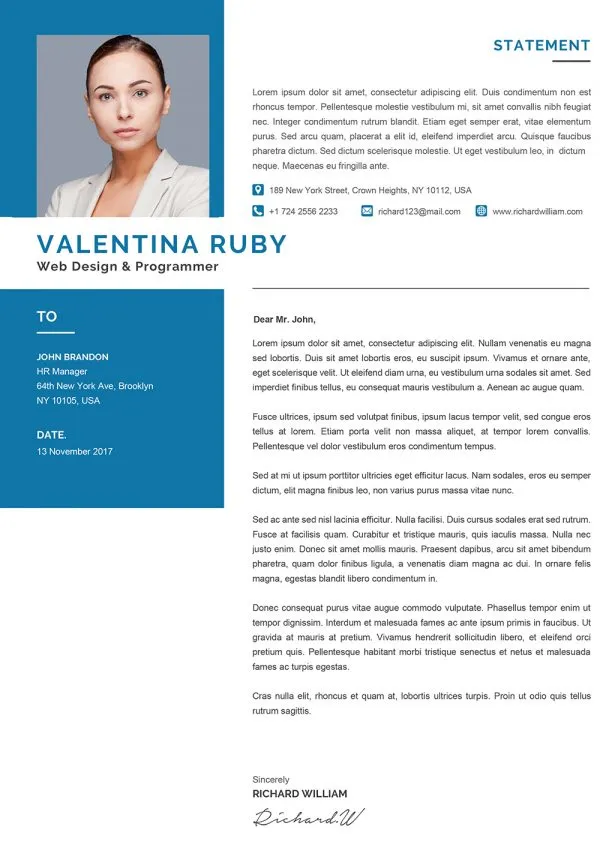
Quantifying your achievements is an effective way to demonstrate the impact of your work. Instead of simply stating your responsibilities, provide data and statistics to show the results you achieved. For example, instead of saying ‘Improved project efficiency,’ you could say ‘Improved project efficiency by 15% by implementing new workflow processes.’ Use numbers, percentages, and specific figures to highlight your successes. This evidence makes your achievements more tangible and provides a clear understanding of your skills and abilities. This gives the hiring manager a concrete understanding of the value you can bring to the company.
Showcasing Your Technical Skills
Engineers should clearly highlight their technical skills in the cover letter. List relevant software, tools, programming languages, and engineering principles you are proficient in. Provide specific examples of how you have used these skills in previous projects. Tailor this section to the specific job requirements, emphasizing the skills that are most relevant. For example, if the job requires experience with CAD software, make sure to mention your experience with that software and give an example of its use. This detailed presentation of your technical expertise demonstrates your ability to perform the job and makes your application stand out.
Demonstrating Your Problem-Solving Abilities
Engineers should demonstrate their problem-solving abilities in their cover letters, as this is a core skill. Provide examples of how you have identified, analyzed, and solved complex engineering problems. Describe the challenges you faced, the steps you took to overcome them, and the results you achieved. For instance, you could describe how you identified a design flaw, developed a solution, and implemented it to improve product performance. Showcase your ability to think critically and find creative solutions to engineering challenges. This demonstrates your resourcefulness and your value to the company.
Highlighting Soft Skills
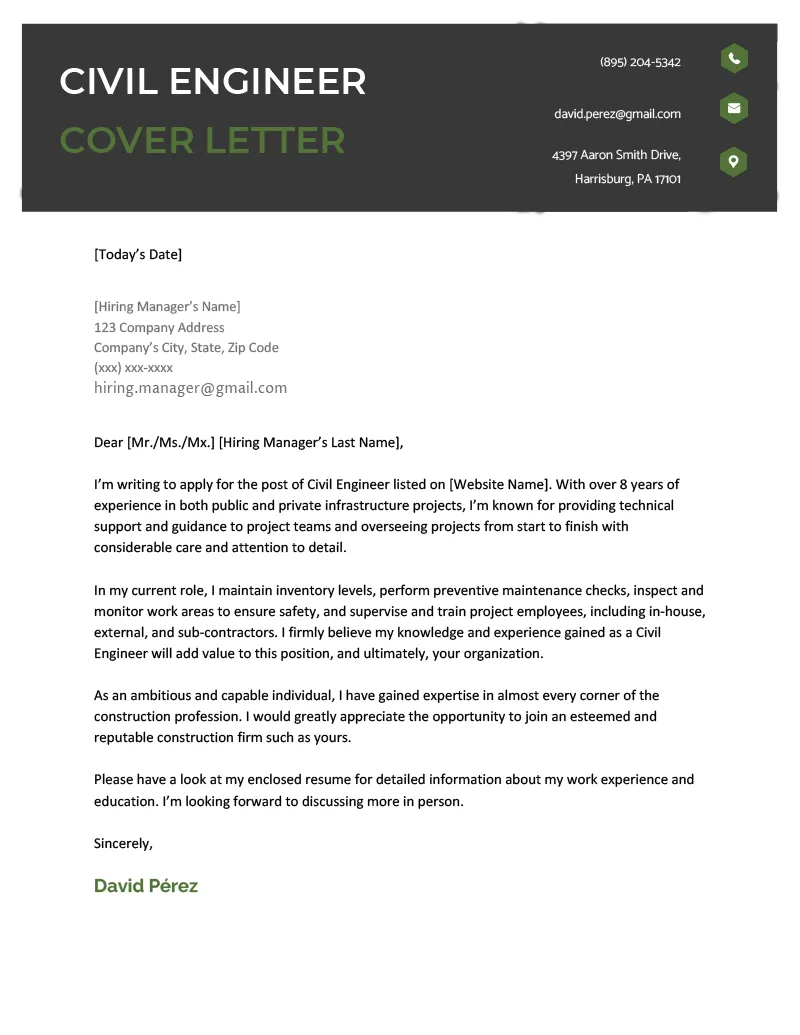
While technical skills are essential, also highlight your soft skills. These include communication, teamwork, leadership, and time management skills. Provide examples of how you have used these skills in previous roles. Describe how you have effectively communicated technical information to non-technical audiences, how you have worked collaboratively in a team environment, or how you have managed projects effectively. Showing a balance of both technical and soft skills portrays you as a well-rounded professional and highlights your ability to excel in any engineering environment.
Writing a Compelling Closing Paragraph
The closing paragraph is your final chance to leave a lasting impression. Reiterate your interest in the position and the company. Summarize your key qualifications and why you are a great fit. Express your enthusiasm for the opportunity and state your availability for an interview. Include a call to action, such as ‘I look forward to hearing from you’ or ‘Thank you for your time and consideration.’ Make sure your closing is professional, enthusiastic, and memorable. Ensure you end on a positive note that motivates the hiring manager to contact you.
Proofreading and Editing Your Cover Letter
Proofreading and editing your cover letter is essential before submitting your application. Check for any grammatical errors, spelling mistakes, and typos. Ensure that the formatting is consistent throughout. Read your letter aloud to catch any awkward phrasing or sentence structure issues. Ask a friend or colleague to review your cover letter for feedback. A polished, error-free cover letter demonstrates your professionalism and attention to detail. This will leave a positive impression on the hiring manager. A well-proofread document also shows your respect for the potential employer and your commitment to quality.
Cover Letter Formatting and Design
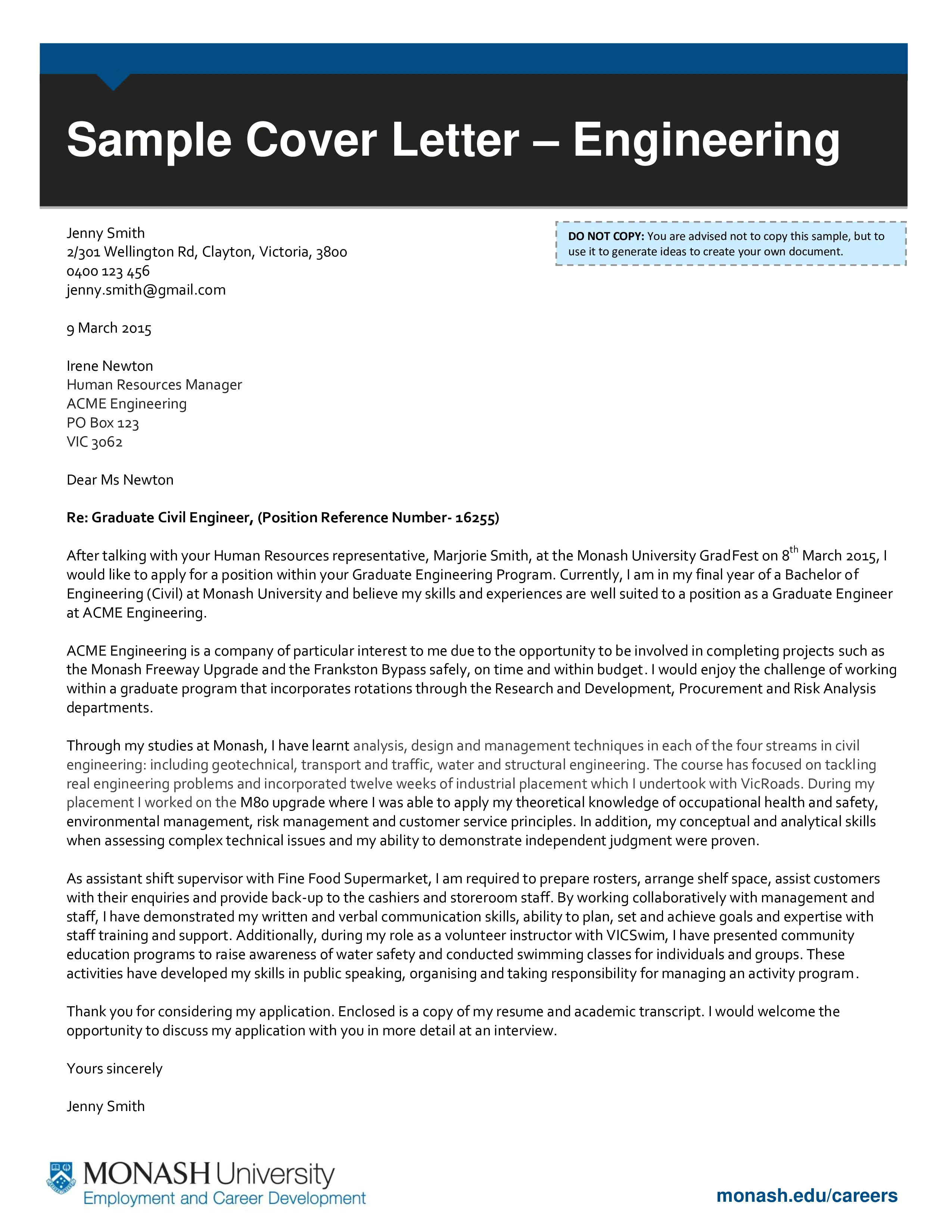
Formatting and design elements significantly impact the readability and professionalism of your cover letter. Use a clean, easy-to-read font like Arial or Times New Roman. Maintain consistent formatting throughout the document, including the font size, line spacing, and margins. Keep your cover letter concise and ideally within one page. Use clear headings and bullet points to make your letter easy to scan. A well-formatted cover letter that is easy to read reflects your attention to detail and makes your application stand out, making it easier for the hiring manager to focus on your skills and qualifications.
Best Practices for Engineer Cover Letter Templates
When using engineer cover letter templates, focus on customizing them to your specific situation. Don’t simply copy and paste the template; instead, adapt it to reflect your unique skills and experiences. Ensure that the template aligns with your personal brand and the job requirements. Research the company and tailor the language and tone of the cover letter to align with their culture. Use the template as a framework but personalize it with your achievements and skills to ensure that your cover letter stands out and demonstrates your individuality and interest in the position.
Engineer Cover Letter Mistakes to Avoid
Several common mistakes can undermine the effectiveness of your engineer cover letter. Avoid using generic cover letters that aren’t tailored to the specific job or company. Do not include irrelevant information or skills that don’t relate to the position. Avoid grammatical errors, spelling mistakes, and typos. Do not exceed one page in length. Finally, avoid a negative tone or complaining about previous employers. By avoiding these common pitfalls, you can create a cover letter that makes a positive impression and increases your chances of getting an interview.
Common Formatting Errors

Common formatting errors in engineer cover letters can create a negative impression. Ensure that the font is clear and readable. Avoid using too many different fonts or font sizes. Maintain consistent margins, spacing, and alignment throughout the document. Make sure that the formatting is the same as the resume. Poor formatting can make your cover letter difficult to read and demonstrate a lack of attention to detail. Consistent, professional formatting showcases your organization skills and increases the cover letter’s impact.
Lack of Specificity and Tailoring
One of the most common mistakes is a lack of specificity and tailoring. Avoid sending a generic cover letter that is not tailored to the specific job or company. Make sure to address the hiring manager by name, if possible. Customize your cover letter to highlight the skills and experiences that are most relevant to the job requirements. Demonstrate your understanding of the company’s mission, values, and culture. A generic cover letter indicates a lack of interest in the position and can reduce your chances of getting an interview. Tailoring demonstrates that you have invested time and effort into your application and shows your genuine interest.
Failing to Proofread and Edit
Failing to proofread and edit your cover letter is a critical mistake that can damage your credibility. Always proofread for grammatical errors, spelling mistakes, and typos. Ensure that your sentences are well-structured and that the overall tone is professional. Read your letter aloud to catch any awkward phrasing or sentence structure issues. A cover letter riddled with errors reflects poorly on your attention to detail. Proofreading and editing your cover letter demonstrates your commitment to quality and professionalism. It is a step that should not be skipped when seeking an engineering position.
Engineer Cover Letter Template Examples
Utilizing engineer cover letter template examples is a good starting point. There are many resources available online, providing you with ready-made templates. While using templates, customize them to reflect your personal information. Focus on personalizing them with your skills and experience, ensuring they align with the job requirements. You can use the examples to understand the structure, language, and tone of a successful cover letter. Tailor it to showcase your unique skills, experience, and genuine interest in the specific job. Use this as an opportunity to craft a great cover letter.
